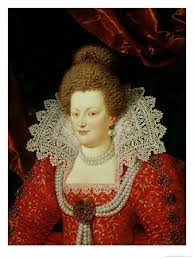
Marie de’ Medici (Maria de’ Medici) (1573-1642) was the wife of Henry IV. She was the daughter of Francesco I, Grand Duke of Tuscany and lived in Florence until her marriage in 1600.
The Florentine court supplied her with several artists who settled in Paris, notably Thomas Francini, Alexandre Francini and Pietro Francavilla, and this influenced her first important commission, an equestrian statue of Henry IV. In 1604 she ordered the statue from Giambologna, and the finished work was placed on the tip of the Ile de la Cité, Paris, in 1614, halfway across the Pont Neuf: the horse by Giambologna, the rider by his assistant Pietro Tacca and the four slaves of the pedestal by Francavilla.
Because of Medici traditions of patronage it is often assumed that the Queen inspired the early 17th-century royal building program in Paris, but there is no evidence that she played any part in it. Her patronage was limited to two other projects during Henry IV’s reign: the decoration of the chapel of the Trinité at the château of Fontainebleau by Martin Fréminet and the completion of the château of Monceaux en Brie by Salomon de Brosse. Marie also planned a tomb for her husband, which was begun in 1613 by one of the Métézeau brothers, Louis or Clément (successive Architects to the King), but never completed.
Marie emerged as an important patron during her regency (1610–1617) for her son, Louis XIII. In 1611 she decided to build a new residence in Paris modeled on her childhood home, the Palazzo Pitti, Florence, and sent Louis Métézeau there to make drawings.
In 1612–1613 de Brosse won the competition for what was to become the Palais du Luxembourg. He set a traditional French château plan in a suburban garden, acknowledging the Florentine model only in his elevations and use of rustication.
The Jardins du Luxembourg, which followed the Boboli Gardens, Florence, in their general layout, were notable for their parterres, designed by Jacques Boyceau, and the architectural grotto, probably by the Francini brothers. To supply the palace with water the Queen had the Arcueil Aqueduct built, in which de Brosse and Thomas Francini were involved. Following a rift with her son in 1617, Marie was forced to spend two years in Blois, where she had de Brosse add a pavilion to the château.
In the 1620s Marie concentrated on the interior decoration of her palace. In 1622 she commissioned Peter Paul Rubens to paint two cycles, the Life of Marie de’ Medici and that of Henry IV. The Marie de’ Medici cycle was installed in the west gallery in 1625; the Henry IV cycle was not executed.
In the Cabinet des Muses she hung a series of paintings by Giovanni Baglione of Apollo and the Nine Muses, and the Cabinet Doré was decorated with a series of works by contemporary Florentine painters (Jacopo Ligozzi, Domenico Passignano, Giovanni Bilivert and others) on the history of the Medici family.
After receiving an Annunciation from Guido Reni, Marie invited the artist to Paris in 1629 to paint the Henry IV cycle.
Reni declined, but other foreigners attended her court: Frans Pourbus the younger, the poet Giambattista Marino and Orazio Gentileschi. Philippe de Champaigne was appointed Peintre de la Reine in 1628.
Among the French artists who enjoyed this contact with Italian culture was Nicolas Poussin, employed at the Palais du Luxembourg around 1621–1623.
After losing a political struggle with Cardinal Richelieu in 1630, Marie left France and ended her life in exile.
The collection she left behind had a lasting impact on French painting and art theory, not by advancing any one style but by introducing the work of Rubens and contemporary Italian painters to Paris.
